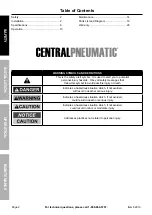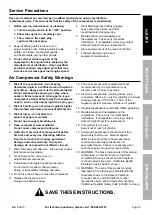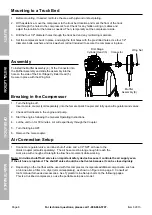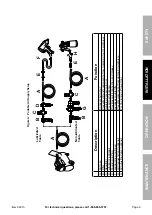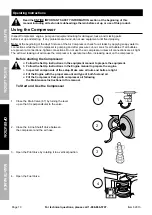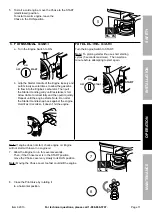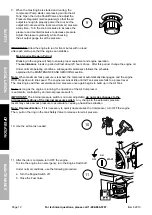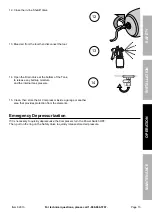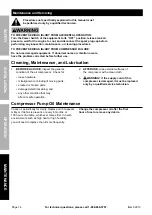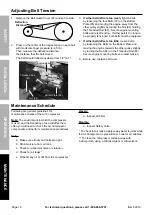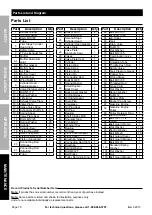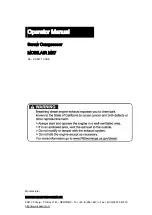
Page 4
For technical questions, please call 1-888-866-5797.
Item 62913
SAFETY
Op
ERA
TION
M
AINTENANCE
INST
ALLA
TION
Operating precautions
1.
CARBON MONOXIDE HAZARD
Using an engine indoors CAN KILL
YOU IN MINUTES.
Engine exhaust contains carbon
monoxide. This is a poison you cannot see or smell.
NEVER use inside a home or garage, EVEN IF
doors and windows are open.
Only use OUTSIDE and far away from windows,
doors, and vents.
2. Keep children away from the equipment,
especially while it is operating.
3. Fire Hazard! Do not fill gas tank while Compressor
engine is running. Do not operate if gasoline has
been spilled. Clean spilled gasoline before starting
engine. Do not operate near pilot light or open flame.
4. Do not touch Compressor engine during
use. Let engine cool down after use.
a.
Do not use the compressor if the switch
does not turn it on and off.
Any compressor
that cannot be controlled with the switch
is dangerous and must be repaired.
b.
Store an idle compressor out of the reach
of children and do not allow persons
unfamiliar with the compressor or these
instructions to operate it.
A compressor is
dangerous in the hands of untrained users.
5. Never store fuel or other flammable
materials near the Compressor engine.
6. Only use a suitable means of transport and
lifting devices with sufficient weight bearing
capacity when transporting the Compressor.
7. Secure the Compressor on transport vehicles to
prevent the tool from rolling, slipping, and tilting.
8. Use only accessories that are recommended
by Harbor Freight Tools for your model.
Accessories that may be suitable for one
piece of equipment may become hazardous
when used on another piece of equipment.
9. Parts, especially exhaust system components,
get very hot during use. Stay clear of hot parts.
10. Do not cover the engine or
equipment during operation.
11.
Maintain the compressor. Keep the compressor
clean for better and safer performance. Follow
instructions for lubricating and changing
accessories. Keep dry, clean and free from
oil and grease. Check for misalignment or
binding of moving parts, breakage of parts
and any other condition that may affect the
compressor’s operation. If damaged, have the
compressor repaired before use.
Many accidents
are caused by a poorly maintained compressor.
12.
Use the compressor in accordance with these
instructions, taking into account the working
conditions and the work to be performed.
Use of
the compressor for operations different from those
intended could result in a hazardous situation.
13. Do not operate the equipment with known
leaks in the engine’s fuel system.
14. When spills of fuel or oil occur, they must be
cleaned up immediately. Dispose of fluids and
cleaning materials as per any local, state, or
federal codes and regulations. Store oil rags in
a bottom-ventilated, covered, metal container.
15. Keep hands and feet away from moving parts. Do
not reach over or across equipment while operating.
16. Before use, check for misalignment or binding
of moving parts, breakage of parts, and any
other condition that may affect the equipment’s
operation.
If damaged, have the equipment
serviced before using.
Many accidents are
caused by poorly maintained equipment.
17. Use the correct equipment for the application.
Do not modify the equipment and do not use the
equipment for a purpose for which it is not intended.


